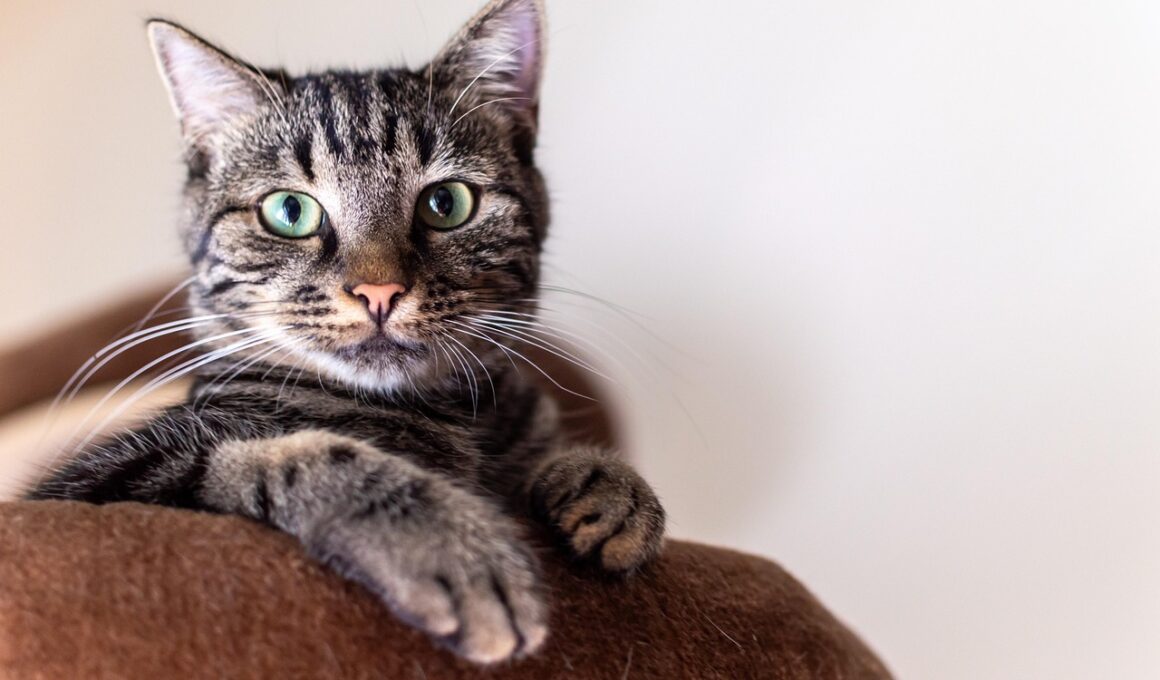Best Practices for Car Travel with Senior Cats
Traveling with a senior cat can be a rewarding experience, but it does require extra preparation and care. Senior cats may have specific needs that younger cats do not, so planning ahead is essential for a smooth journey. Start by ensuring your cat is healthy enough for travel; a visit to the vet can help identify any issues. Additionally, consider your cat’s temperament; some senior cats may be more anxious in new environments. To increase their comfort, use a familiar carrier that they associate with safety. Remember to line the carrier with soft bedding to make it cozy. Before the trip, practice short rides to acclimatize them to car travel, ensuring they feel secure. Keep familiar items like their favorite blanket or a toy in the carrier. Travel during cooler times of the day to ensure your cat is comfortable and safe. Bring enough food and water for the journey, and make frequent stops to allow them to stretch. Preparing well will help you both enjoy your adventures together.
Providing Comfort During the Journey
During car travel, comfort is essential for senior cats who may experience anxiety or discomfort due to movement. To alleviate stress, ensure your cat’s carrier is well-ventilated, as warm air can accumulate quickly in enclosed spaces. If your cat seems restless, consider using calming aids suggested by your veterinarian. Bring along a blanket that smells like home to help soothe your pet during the trip. Set up a safe environment inside the vehicle, free of loose items that could pose a hazard during turns or sudden stops. Use cushioned pads or towels inside the carrier for added support, particularly for older cats with joint issues. Always secure the carrier in place using seat belts to avoid excessive movement or accidents. Throughout the journey, maintain a calm demeanor, speaking softly to your cat can help ease their anxiety. If possible, play gentle music that you know they enjoy. Keep an eye on their behavior to assess stress levels; you can offer calming treats if they seem particularly anxious. The goal here is to create a serene travel environment for your senior cat.
Feeding routines are critical during travel, especially for senior cats who may have delicate stomachs. Before your trip, adjust their feeding schedule to avoid any digestive issues. Offer a light meal 4-6 hours before traveling to prevent car sickness. Bring their regular food to maintain consistency, as sudden dietary changes can lead to upset stomachs. When stopping for breaks, offer small portions of food and remember to keep them hydrated. A portable water dish and fresh water are essential and should be accessible at all times. Monitor their eating habits closely, and if your senior cat refuses to eat during the trip, contact a veterinarian. It’s also essential to limit treats to avoid upsetting their stomach. If your cat has specific dietary restrictions, ensure you accommodate them during the journey. Expect that your cat might be less interested in food during travel and be patient if they do not eat on schedule. Adjusting how and when you feed them while on the go helps maintain their health and comfort. Plan for meal times, as a consistent routine is critical in keeping your pet happy.
Frequent Breaks for Potty and Stretching
Taking frequent breaks ensures your senior cat gets the necessary stretching and bathroom opportunities. Schedule stops every couple of hours, allowing your cat to relieve themselves, walk around, and settle back comfortably. During these breaks, securely place the carrier in a safe spot to prevent escapes. Carry a portable litter box with you; this is particularly beneficial for older cats who might need to go more often. Ensure you have litter on hand for quick clean-ups during these breaks. Allow your cat to explore outside their carrier in a safe, enclosed area while keeping a close eye on them. Many senior cats may have mobility issues, so a short, gentle walk on a harness and leash could be a great way to soothe them. Additionally, these breaks provide a chance for you to bond and reassure your pet, which is essential for their emotional well-being. Maintaining regular routines despite changes in surroundings can greatly benefit your senior cat’s mental state while traveling. Ensuring they have enough time to stretch and relieve themselves will keep them relaxed throughout the journey.
Older cats may require adaptive measures to make traveling safe and hassle-free. Many cats may become stressed when traveling, primarily if they have health issues related to aging. One must ensure their health is optimal before traveling; taking them for a vet check-up can prevent possible emergencies. Keep all necessary medications within easy reach during the journey. Bring a copy of any necessary prescriptions or health records for emergencies. Make sure to take frequent breaks, especially if your cat has mobility issues, giving them time to move around and relieve themselves. Additionally, consider using calming sprays or pheromones that may help your cat feel more secure in unfamiliar settings. A familiar blanket or toy can also greatly alleviate their anxiety. It’s crucial to have a backup plan in case of unexpected events, such as a need for veterinary care on the road. Use a reliable carrier that meets your cat’s size and comfort needs; it should feel like their safe place. Ensuring that everything is handled well ahead of the journey reduces worries about traveling with an aging cat.
Post-Travel Care for Senior Cats
Once you arrive at your destination, providing suitable accommodations for your senior cat is critical. Cats need time to adjust to new environments, especially when traveling. Set up a cozy area with familiar items like their bedding and toys, which can help soothe them after the journey. Allow them time to explore their new surroundings while providing a secure hideaway if they feel overwhelmed. The new environment can be disorienting, particularly for older cats, so keeping them in a familiar space can ease this transition. Check your cat’s health and behavior after arriving; ensure they drink water to stay hydrated. Monitor them closely for signs of stress or discomfort, and adjust their environment as needed. When possible, keep their routine similar to what they were used to at home, including feeding and litter habits. This routine will help minimize their anxiety and make them feel more at ease. Be patient as they acclimatize, allowing them to settle at their own pace. This careful approach will enhance their comfort and ensure they enjoy their stay.
Traveling with senior cats requires consideration for their specific needs. Being attentive to their comfort, health, and adaptive advantages can ensure an enjoyable and less stressful journey. Senior cats often face health challenges; thus, preparing for emergencies and having a well-stocked travel kit is vital. Essential items should include their food, medications, water, and a familiar blanket or toy. A portable litter box can also be invaluable during your travels. Planning your route with frequent breaks will help maintain your cat’s comfort and minimize anxiety. During downtime, encourage them to stretch and explore when safely possible, as this can help alleviate travel stress. Remember to remain calm throughout the travel experience, as your demeanor influences your cat’s stress levels. Using calming sprays or natural remedies may also support their emotional well-being during the journey. Lastly, consider making the car environment relaxed, with soft music and gentle driving. Protecting their health and well-being is paramount when embarking on these adventures together. By following these practices, you can create positive travel experiences with your beloved senior pet.


